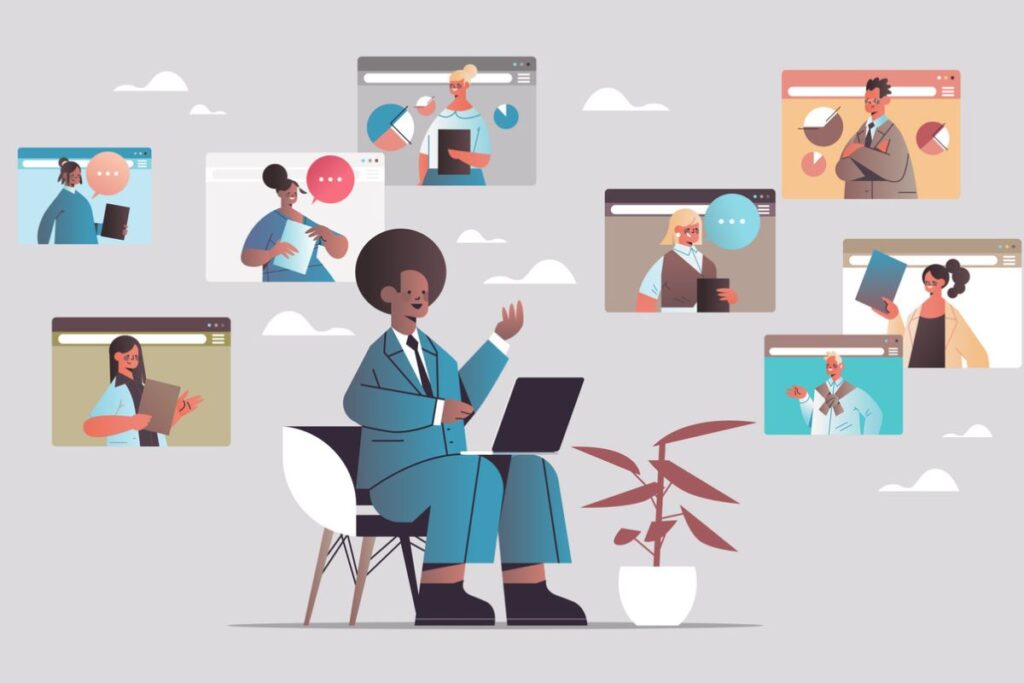Summary: True equity in hybrid and remote learning means every participant, wherever they are, is empowered to contribute. Inclusive session design ensures that each perspective is valued, encouraging engagement and growth.
Every Learner Deserves a Seat—And a Voice
A fundamental concept to effective learning is equity. Hybrid sessions can be designed to effectively bridge the gaps between the different stakeholders. This creates a space where every individual has equal footing, access and opportunities.
Hybrid meetings often expose hidden gaps. Onsite participants have physical proximity to facilitators and peers, catching subtle cues and side conversations. Remote participants risk being one step removed: out of the room, out of focus, and sometimes, out of mind. With no purposeful intervention, these differences can undermine engagement, creativity, and morale.
To deliver on the promise of equity, facilitators must scrutinize every step of the session—from invitations to follow-up. This starts with establishing clear, enforceable expectations for sharing time and access to resources. A few ideas that can be implemented are to:
- Use platforms that enable everyone to raise a hand, contribute in conversations, or participate in polls, regardless of their location.
- Rotate leadership and reporting responsibilities so both remote and onsite participants are recognized as equal contributors.
- Make it routine to ask, “Whose voice have we not yet heard?” and adjust in real time.
Not all barriers are obvious. Time zones, home environments, language differences, and technology access all affect how easily someone engages. A session designed for true equity anticipates these, from scheduling to accessibility tools to flexible participation options. In this way, every individual’s perspective is not just accepted but genuinely sought out as vital to the group’s learning.
Inclusive Learning by Design—More Than Meeting Minimums
Designing for inclusion is not a compliance exercise or a ticked box. It’s a mindset—a way of working that expects, welcomes, and requires all voices. This is where session design becomes a lever for real growth, not just a facilitator’s checklist.
Begin by setting inclusive expectations at the outset. Make it clear that participation is not simply allowed but encouraged, and that diverse viewpoints will shape outcomes. Offer choices in how stakeholders engage—spoken, written, visual, synchronous, or asynchronous—so each individual can operate from their strengths. Distribute agendas and prompts beforehand, providing everyone, not just the few who can “think on their feet,” the chance to prepare.
Accessibility is a mark of respect, not an extra. Commit to universally accessible materials: closed captions, clear visuals, and interfaces that support assistive technologies. Have protocols for addressing common digital obstacles, such as bandwidth drops or lost connections, so participants know in advance how to rejoin or catch up.
Most importantly, treat feedback as an engine for continuous improvement. Regularly check in with participants: What made engagement easier? What stood in the way? Adapt session structures—experiment, evaluate, iterate—to show that listening results in action, not just acknowledgment.
To strengthen this practice, consider incorporating asynchronous learning components where participants can interact with content at their own pace. This flexibility allows deeper reflection and more thorough engagement, catering to different learning preferences and schedules. By valuing asynchronous interactions as equally significant to synchronous ones, organizations make a clear statement: learning can happen anywhere, at any time, and everyone’s process is respected.
What Happens When Every Voice Is Genuinely Included
Engagement deepens when stakeholders know their perspectives matter. A remote-first or hybrid approach, when grounded in equity, invites richer dialogue and broader exploration of ideas. This balance energizes sessions: participants are more willing to share, respond, and invest.
In environments where equity is prioritized, team members tend to feel more confident, connected, and ready to participate—not just as recipients of information, but as valued partners in collective learning. The diversity of thought, experience, and approach naturally expands, and new ideas surface more frequently. What follows are smarter questions, sharper insights, and a culture that encourages practical experimentation—critical for building organizational agility.
Importantly, these inclusive practices often lead individuals to extend newfound trust and autonomy beyond the session itself. Participants mirror what they experience, cultivating habits of transparency, respect, and creative risk-taking across the organization.
An example that underscores this point is an organization implementing equity-driven learning sessions to address company-wide challenges. By involving employees from all levels and locations, this company could discover untapped potential in their workforce and implement innovative solutions that might have remained unvoiced. Reinforce the idea that inclusivity is not just an ideal but a concrete strategy for discovering and leveraging talent across dispersed teams.
Equity Is an Ongoing Commitment
Designing and sustaining equity in remote engagement is a continuous process. It requires vigilance, adaptability, and ongoing dialogue. For organizations determined to keep pace with the demands of modern work, this commitment is not just the right thing to do—it is a competitive advantage. By making every voice count, organizations transform learning into a powerful force for trust, connection, and meaningful progress.
Moving forward, work on a partnership ethos, where participants and leaders collaborate continually to refine practices. The journey toward equity is iterative—it involves recalibration in response to changing dynamics and participant feedback. By prioritizing equity as a core value, rather than a peripheral concern, organizations ensure they align with both their ethical standards and their strategic goals.

